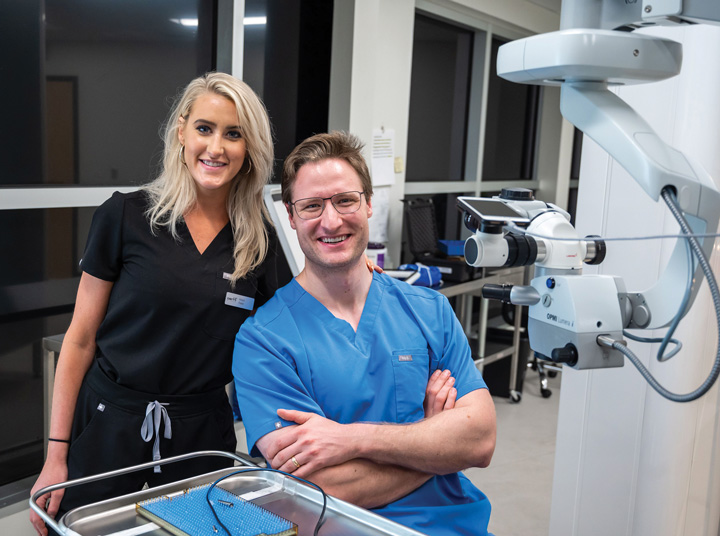- Home
- Article
OR Excellence Awards: Pain Control: Lowest Doses at the Perfect Times
By: Adam Taylor | Senior Editor
Published: 9/7/2023
Knoxville Orthopaedic Surgery Center credits its anesthesiologists with the facility’s many achievements.
As more and more total joint replacements take place in ambulatory surgery centers and hospital outpatient departments, people often attribute the migration to new medical devices, the advent of robots or surgical techniques.
Leadership at Knoxville (Tenn.) Orthopaedic Surgery Center (KOSC) doesn’t think that’s true. Rather, the center believes it’s how it manages its patients perioperatively, allowing them to be safely discharged a few hours after getting a new knee or hip — and a key element of that is how anesthesia is deployed. Its anesthetic techniques are designed with patients’ desire for same-day discharges in mind.
Those techniques, as well as the facility’s leadership giving credit where credit is due, are why Knoxville Orthopaedic is the winner of the 2023 OR Excellence Award for Pain Control.
Beth Russell, executive director at KOSC, says the anesthesiologists, who are fellowship-trained in regional anesthesia as well as critical-care anesthesia, combine preoperative nerve blocks with intraoperative injections at the surgical site. “This combination pain control method allows for the patient to be kept comfortable during the surgery and recovery, and allows for a timely discharge home,” she says. Ms. Russell notes that the process to minimize postoperative pain control begins in the pre-op bay before a patient receives their IV start. The oral cocktail usually includes acetaminophen, celecoxib, gabapentin and small doses of oxycodone. Patients also receive a spinal anesthetic immediately preceded by a benzodiazepine. Then comes the nerve block, placed with ultrasound guidance, using a low volume of local anesthetic designed to minimize postoperative pain while still allowing for safe movement when the patient returns home.
Intraoperatively, MAC sedation using propofol is administered via infusion pumps, which allows for faster recoveries than general anesthesia and intraoperative narcotics. After the procedure, a local anesthetic and an analgesic are injected directly into the joint. Post-op, the hope is that no medication is needed, although acetaminophen or ketorolac is used — as is a narcotic in very rare instances.
KOSC has been operating for 14 years and its pain control methods have evolved over time. Its mix of prudent patient selection, optimizing patients for surgery, standardizing the pain control protocols most patients receive and considering the anesthesia practice as a true partner that collaborates with the surgeons and management team has been fine-tuned to the point that the facility can now treat and safely discharge a high volume of patients each day.
For example, patients once required an ASA I classification but now they can have an ASA II classification. While surgeons and anesthesiologists once met with patients two weeks before a procedure, pre-op assessments now begin with a phone call from a nurse. Also, each medication in the pre-op recipe is added at a time in which it fits in with the center’s overall workflow.
That means that the anesthesia team must time its work to integrate with the center’s practice of having surgeons operating in two different rooms on one patient at a time. After a surgeon finishes the actual joint replacement, a physician’s assistant performs the wound closure. Then the surgeon walks into the other OR for the next case to make the incision — and the anesthesia team must have that patient ready to go. This requires precise timing of the block placement, as well as when the medications are administered. The patients need to be sedated enough to undergo surgery, and alert enough four hours later to be able to go home.
“Finding the minimum effective dose of everything is the key,” explains Cannon E. Turner, MD, the facility’s chief anesthesiologist. OSM

Parker Cornea in Birmingham, Ala., has a reputation for performing complex cases using the most advanced techniques and technologies, which many eye practices in its area can’t manage.
The facility of course uses regional for complicated cases and topical anesthetics for routine operations. “But overall, we have found the best anesthetic is not local, but vocal — that is, having a calming, pleasant environment with attentive and kind staff,” says Jack Parker, MD, PhD, a partner and ophthalmologist at the practice that also has two satellite locations in Alabama and another in Mississippi. The Vocal Local (VL) concept essentially emphasizes the comfort patients experience from a familiar relationship with their providers. Having a surgical experience in which some protocols, such as not having to wear a gown, can reduce patient anxiety, as can pleasant conversations with staff members the patients already know.
“Because our surgical facility is located within our normal clinic, the surgical staff are the same familiar faces that helped work the patients up and evaluate them for surgery in the first place,” says Dr. Parker. The practice was founded by Dr. Parker’s father, John S. Parker, MD, in 1997.
Patients aren’t required to have IVs or be NPO the night before their procedure, which puts them even more at ease — and makes the rules for their actual surgeries even more relaxed.
Parker Cornea treats patients from other states and countries and always involves their local doctors in the treatment plan so patients can return home for virtually all their aftercare needs. The facility’s website says anxiety medications are available to patients if needed and invites patients to bring their family to the facility and watch the procedure live on a video broadcast.
Parker Cornea’s way of doing business is an example of how sound implementation of VL concepts can improve a practice and help its patients by creating an environment that provides successful outcomes — all while delivering quick procedures and prompt discharges without an overreliance on traditional pain control substances.
—Adam Taylor
.svg?sfvrsn=be606e78_3)
.svg?sfvrsn=56b2f850_5)